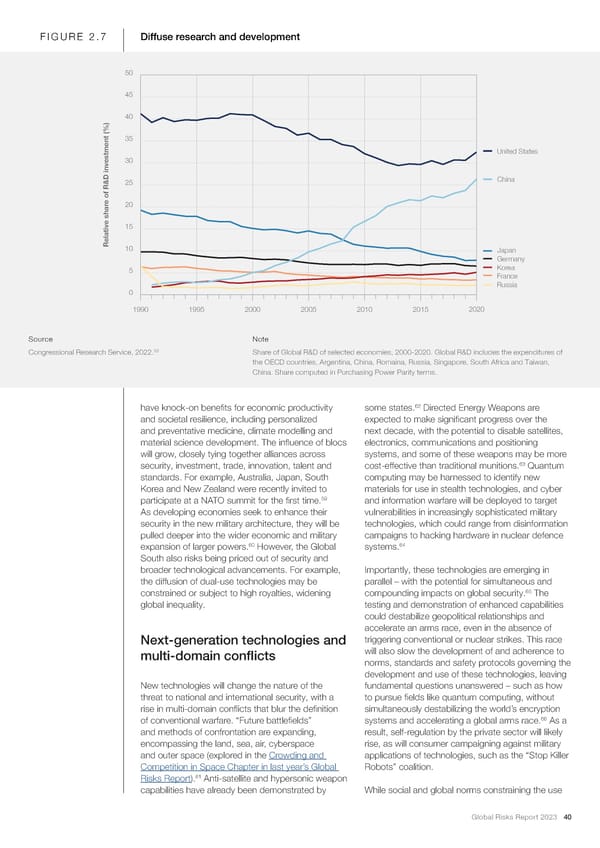FIGURE 2.7 Diffuse research and development 50 45 40 35 United States 30 25 China e of R&D investment (%)20 15 Relative shar10 Japan Germany 5 Korea France Russia 0 1990 1995 2000 2005 2010 2015 2020 Source Note Congressional Research Service, 2022.58 Share of Global R&D of selected economies, 2000-2020. Global R&D includes the expenditures of the OECD countries, Argentina, China, Romaina, Russia, Singapore, South Africa and Taiwan, China. Share computed in Purchasing Power Parity terms. 62 have knock-on bene昀椀ts for economic productivity some states. Directed Energy Weapons are and societal resilience, including personalized expected to make signi昀椀cant progress over the and preventative medicine, climate modelling and next decade, with the potential to disable satellites, material science development. The in昀氀uence of blocs electronics, communications and positioning will grow, closely tying together alliances across systems, and some of these weapons may be more 63 security, investment, trade, innovation, talent and cost-effective than traditional munitions. Quantum standards. For example, Australia, Japan, South computing may be harnessed to identify new Korea and New Zealand were recently invited to materials for use in stealth technologies, and cyber 59 participate at a NATO summit for the 昀椀rst time. and information warfare will be deployed to target As developing economies seek to enhance their vulnerabilities in increasingly sophisticated military security in the new military architecture, they will be technologies, which could range from disinformation pulled deeper into the wider economic and military campaigns to hacking hardware in nuclear defence 60 64 expansion of larger powers. However, the Global systems. South also risks being priced out of security and broader technological advancements. For example, Importantly, these technologies are emerging in the diffusion of dual-use technologies may be parallel – with the potential for simultaneous and 65 constrained or subject to high royalties, widening compounding impacts on global security. The global inequality. testing and demonstration of enhanced capabilities could destabilize geopolitical relationships and accelerate an arms race, even in the absence of Next-generation technologies and triggering conventional or nuclear strikes. This race multi-domain con昀氀icts will also slow the development of and adherence to norms, standards and safety protocols governing the development and use of these technologies, leaving New technologies will change the nature of the fundamental questions unanswered – such as how threat to national and international security, with a to pursue 昀椀elds like quantum computing, without rise in multi-domain con昀氀icts that blur the de昀椀nition simultaneously destabilizing the world’s encryption 66 of conventional warfare. “Future battle昀椀elds” systems and accelerating a global arms race. As a and methods of confrontation are expanding, result, self-regulation by the private sector will likely encompassing the land, sea, air, cyberspace rise, as will consumer campaigning against military and outer space (explored in the Crowding and applications of technologies, such as the “Stop Killer Competition in Space Chapter in last year’s Global Robots” coalition. 61 Risks Report). Anti-satellite and hypersonic weapon capabilities have already been demonstrated by While social and global norms constraining the use Global Risks Report 2023 40
 2023 | Global Risks Report Page 39 Page 41
2023 | Global Risks Report Page 39 Page 41